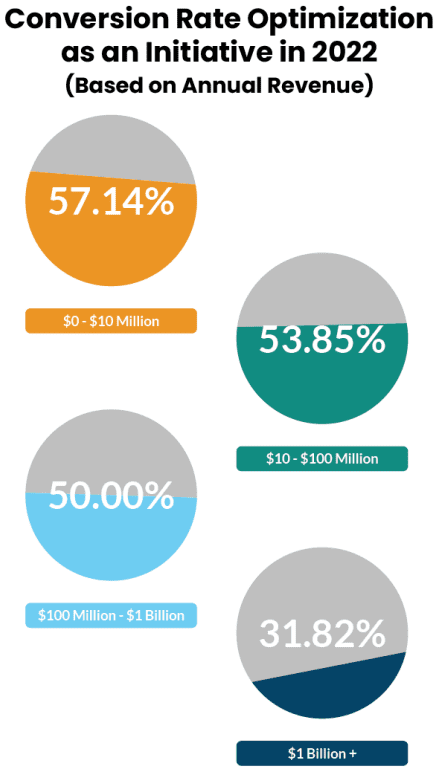
Your paid search advertising and organic search engine optimization efforts help lead shoppers to your website. But without ecommerce conversion rate optimization (CRO) efforts, even the biggest boost in traffic from paid ads and SEO won’t touch your bottom line.
To gain a deeper understanding of the current ecommerce landscape, we surveyed 170 digital marketing professionals about their top-of-mind trends, initiatives, and concerns for 2022. CRO is tied with paid search as the top priority among digital marketing decision-makers for 2022. In this article, uncover conversion rate optimization tips and discover how running A/B tests can help you rake in more online revenue.
The purpose of all digital marketing boils down to getting more sales – in other words, generating conversions. Optimizing your ads and your website to increase conversions is everything. After all, the valuable time that your company spends creating ads means nothing if customers don’t click them, and those clicks mean nothing if the customer doesn’t convert once they get to your site.
51.7% of digital marketing professionals say conversion rate optimization is a big initiative for their brand in 2022.
The importance of optimizing for conversions varies based on a company’s annual revenue. As a business generates more sales and drives more conversions, conversion rate optimization steadily becomes a lower priority. It’s a top initiative for more than 50% of brands with under $1 billion in annual revenue compared to just 31.9% of brands making over $1 billion.

While mobile reigns in terms of traffic and impressions, when it comes to conversion rates, desktop is king. As of Q3 2021, the average conversion rate of online shoppers on desktop is 3.7% compared to just 2.2% for mobile. Tablets have a conversion rate of 3.3%.
Conversion Rate Optimization Strategies
You can optimize your brand’s presence for conversions across your entire digital marketing strategy, including:
- Your website’s checkout experience (e.g. button text, colors, and copy)
- Landing page copy on your website (e.g. complimentary vs. fear-based language)
- Ad copy on Amazon, paid search, social media, or anywhere else you advertise
- Content and images in promotional emails and newsletters that you send to your customer database
Whether you’re optimizing for clicks, sales, impressions, or other factors, your conversion rate optimization strategy should aim to improve your customer experience and reduce friction to make it as simple as possible for a user to perform the action you want. Amazon was able to improve customer experience by more than 25% by adding a “Buy now with 1-Click” button instead of only offering an “Add to cart” option. The 1-Click option removes the shopping cart altogether and enables shoppers to make purchases without having to re-enter their payment and shipping information, eliminating significant friction to make it even quicker and easier for customers to make a purchase.
A few ways you can optimize your conversion rates include:
- Remove the navigation bar from your landing page to encourage users to click where you actually want them to
- Display customized, personalized CTAs based on a specific user’s demographics and lead status
- Ensure your website’s page speed is fast enough (ideally loading within two seconds) to prevent interested users from bouncing
Tracking the right key performance indicators (KPIs) is crucial in digital marketing. Being able to prove that the budget your business is putting toward generating more revenue is actually contributing to generating more revenue is easier said than done. For data-driven marketers, conversion rate is the top metric to track. 37.7% of digital marketing professionals say they use conversion rate metrics as a KPI, followed by return on investment at 17.9% and customer lifetime value at 11.6%.

A/B Testing for Ecommerce Conversions
A/B testing (also known as split testing) is a key component of conversion rate optimization. With A/B testing, ecommerce brands can run a randomized experiment to show two different versions of a campaign to their target audience and determine which resonates the most. Some common factors that are used in A/B tests are landing page copy, email subject line, or button color.
A/B tests are a key way to determine how you can drive more conversions from your website, emails, and other marketing efforts. Companies that split test all their marketing emails see 37% higher returns than companies that don’t. In fact, growing your email CTR by just 0.5% can result in as much as 25% revenue growth. The most commonly tested items in emails are subject lines, images, and content.
The key to A/B testing is understanding that you’ll likely get unexpected results. That’s why it’s so important to perform. Making assumptions about what you think will increase conversions the most based on what resonates with you as opposed to your target audience is a recipe for disaster.
Brands that nurture a culture of experimentation through split testing will lead the pack in 2022. If you’re running A/B tests on your campaigns, you have the opportunity to build your company’s culture of experimentation. You can be the champion who helps your company embrace testing and increase conversions both short-term and long-term.
Case Study | Home Goods Brand Optimizes for Conversions On average, only 12-15% of A/B tests have a winning result. But at ROI, we have an A/B test win rate of 42%! We helped one home goods brand increase their conversion rates by 34% after performing successful A/B tests on their mobile site. Read the case study here to learn more.

Tying It All Together
Ecommerce conversion rate optimization is a major industry-spanning concern. Acquiring traffic is always important for continued growth – but your traffic is worthless if it never converts. At ROI Revolution, our digital marketing experts help ecommerce brands like yours eliminate friction, boost motivation, and streamline the user journey on their website by optimizing for conversions. Reach out to an expert today to uncover the profitable wins waiting to be found from our conversion rate optimization services.
Sources
- ROI Revolution. 2022 State of Digital Marketing Survey Data.
- Statista. Conversion rate of online shoppers in the US as of 3rd quarter 2021, by device.
- NotifyVisitors Blog. 27 Valuable A/B Testing Statistics To Follow in 2022.
- eMarketer. For data-driven marketers, it’s all about conversion rates.
- Litmus. The ROI of Email Marketing [Infographic].



